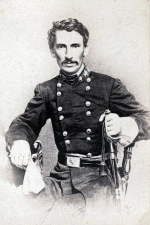Specifications:
Displacement unknown
Length unknown
Beam unknown
Depth of Hold unknown
Draft unknown
Speed unknown
Complement unknown
Armament unknown
Propulsion steam
| Click On Image For Full Size Image | Size | Image Description | Source | |
|---|---|---|---|---|
 |
221k | Thompson was a colonel in the Missouri state guard at the outbreak of the Civil War. In late July of 1861, he was appointed brigadier general of the First Division, Missouri State Guards. He commanded the First Military District of Missouri, which covered the territory from St. Louis to the southern tip of the state along the Mississippi River, encompassing most of the swampy southeastern quarter of Missouri. His brashness, clever maneuvering and boastful proclamations in the first year of the war earned him the nickname, "Swamp Fox of the Confederacy," echoing the exploits of that other "Swamp Fox," Francis Marion, who gained his fame in the Carolina swamps during the Revolutionary War. Thompson's battalion became known as the "Swamp Rats" for their exploits. When Union General John C. Fremont issued an emancipation proclamation purporting to free the slaves in Missouri, Thompson declared a counter-proclamation and his force of 3,000 soldiers began raiding Union positions near the border in October. On October 15, 1861, Thompson led a cavalry attack on the Iron Mountain Railroad bridge over the Big River near Blackwell in Jefferson County. After successfully burning the bridge, Thompson retreated to join his infantry in Fredericktown. Soon afterwards, he was defeated at the Battle of Fredericktown and withdrew, leaving southeastern Missouri in Union control. After briefly commanding rams in the Confederate riverine fleet in 1862, Thompson was ordered west of the Mississippi and participated in a number of actions before returning to Arkansas and accompanying Gen. John S. Marmaduke on an 1863 raid into Missouri. Shortly after this raid he was captured in Arkansas (August 1863) and spent time in St. Louis' Gratiot Street prison, as well as at the Fort Delaware and Johnson's Island prisoner-of-war camps before being exchanged for a Union general in the spring of 1864. Returning to southeast Missouri, he joined Major General Sterling Price's Missouri expedition, taking command of "Jo" Shelby's famed "Iron Brigade" when Shelby became division commander. In March of 1865, Thompson was appointed commander of the Northern Sub-District of Arkansas. He surrendered his troops on May 11, 1865, in Jacksonport, Arkansas. |
||
 |
255k | "Battle of Fort Pillow, 3rd Position" Engraving published in Rear Admiral Henry Walke's Naval Scenes and Reminiscences of the Civil War in
the United States ... (1877), depicting the action between the Confederate River Defense Fleet and Federal ironclads near Fort Pillow, Tennessee, 10 May 1862.
Confederate ships, seen at left, include:
CSS Colonel Lovell, CSS General Beauregard, CSS General M. Jeff Thompson, CSS General Bragg, CSS General Sumter, CSS Little Rebel and CSS General Earl van Dorn. The Federal ironclads, in the center and right, are: USS Carondelet, USS Cincinnati, USS Mound City, USS Benton, USS Saint Louis, USS Cairo and USS Pittsburg. A tug is seen in the right foreground. US Naval History and Heritage Command photo # NH 42755 |
Tommy Trampp | |
 |
177k | "The Great Naval Battle before Memphis, June 6, 1862". Engraving after a sketch by Alexander Simplot, published in "Harper's Weekly",
depicting the action between the Confederate River Defense Fleet and Federal warships off Memphis, Tennessee. In the foreground, the print depicts the Confederate ships
(from left to right):
CSS General M. Jeff Thompson (shown sinking); CSS Little Rebel (shown burning); CSS General Sterling Price; CSS General Beauregard (shown being jammed by the Ellet Ram USS Monarch; CSS General Bragg (shown aground) and CSS Colonel Lovell (shown sinking). In the background are the Federal warships (from left to right): USS Queen of the West; USS Cairo; USS Carondelet; USS Louisville; USS Saint Louis; a tug; and USS Benton. The city of Memphis is in the right distance, with a wharf boat by the shore. Harpers Weekly, 28 June 1862. Sons of the South - Memphis Naval Battle US Naval History and Heritage Command photo # NH 58891 |
Robert Hurst | |
 |
232k | "Closing-Scene of the Naval Engagement Before Memphis, Tennessee., 6 June 1862" Line engraving published in Harper's Weekly, 1862. Ships shown
are (from left to right):
CSS General Earl Van Dorn (escaping, with the Federal fleet in pursuit); CSS General Sumter (captured); CSS General Beauregard (sinking) and CSS General M. Jeff Thompson (blowing up). US Naval History and Heritage Command photo # NH 59053 |
Tommy Trampp | |
 |
92k | Line engraving "Appearance of the Rebel Ram Beauregard and Jeff Thompson after the Fight.", off Memphis, TN., 6 June 1862. published in
"Harper's Weekly", 1862. CSS General Beauregard has sunk to her superstructure deck in right center, with smoke still coming from her stack.
A Federal tug is standing by in the right center. CSS General M. Jeff Thompson is burning, with only smoke visible, in the far right background.
US Naval History and Heritage Command photo # NH 59054 |
Robert Hurst | |
CSS General M Jeff Thompson
Dictionary of American Naval Fighting Ships (DANFS)
| Back To The Navsource Photo Archives Main Page | Back To The Old Navy" Steam and Sail Index |
| Comments, Suggestions, E-mail Webmaster. |
|
This page is created and maintained by Gary P. Priolo |